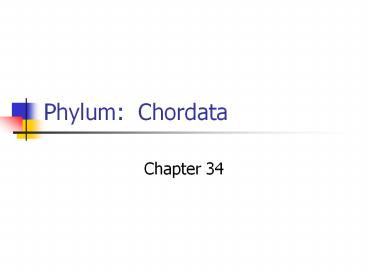Phylum: Chordata - PowerPoint PPT Presentation
1 / 11
Title:
Phylum: Chordata
Description:
... (keratin), ectothermic, three chambered heart (i.e. turtles, lizards, and alligators) Major Divisions Birds (subdivision of reptiles): amniotic eggs, scales ... – PowerPoint PPT presentation
Number of Views:154
Avg rating:3.0/5.0
Title: Phylum: Chordata
1
Phylum Chordata
- Chapter 34
2
What you need to know!
- The 4 chordate characteristics.
- Adaptations that allowed animals to move onto
land. - Traits which distinguish each of the following
groups Chondrichthyes, Osteichthyes, Amphibia,
Reptilia, Birds, and Mammalia. - How the 3 classes of mammals differ in their
reproduction.
3
Characteristics of all Chordates
- Notochord Longitudinal, flexible rod located
between the digestive and the nerve cord - Nerve cord (dorsal, hollow) eventually develops
into the brain and spinal cord (arthropods
ventral) - Pharyngeal slits become modified for gas
exchange, jaw support, and/or hearing - Muscular, postanal tail
4
Neurulation (Vertebrates)
- Neural Tube dorsal folding of the ectoderm
forming a hollow nerve tube - Neural Crest embryonic cells (mesoderm) near the
neural tube that migrate throughout the body to
form special bones like the jaw and cranium - Animation
- http//learningobjects.wesleyan.edu/neurulation/an
imation.php
5
Macroevolutionary Trends
6
Vertebrata
- Pronounced Cephalization concentration of
sensory and neural equipment in the head - Cranium (skull) encloses brain
- Endoskeleton notochord becomes cartilage or
bone (vertebral column) enclosing the hollow
nerve chord - Bone is more advanced than cartilage
- Hinged Jaw
- Closed circulatory system with a ventral
chambered heart
7
Land Adaptations
- Gills ? lungs
- Paired lobed fins ? legs (tetrapod)
- Amniotic Egg (shelled egg) several
extraembryonic membranes that are not part of the
embryo, but produced by embryonic tissue - Amnion protects embryo, contains amniotic fluid
for shock absorption - Allantois forms extra sac for waste disposal
and gas exchange - Yolk Sac nutrient stockpile
- Chorion gas exchange
8
Amniotic Egg
9
Major Divisions
- Fish
- Class Chondrichthyes flexible endoskeletons and
jaws (i.e. shark and stingray) - Class Osteichthyes (bony fish) most numerous
vertebrates, boney endoskeleton, scales (i.e.
trout and salmon) - Class Amphibia gas exchange across skin (most
use lungs), soft water-based eggs, larvae have
two-chambered hearts, adults have three chambers
(i.e. frogs and salamanders) - Class Reptiles gas exchange in lungs,
intercourse, amniotic egg, scales (keratin),
ectothermic, three chambered heart (i.e. turtles,
lizards, and alligators)
10
Major Divisions
- Birds (subdivision of reptiles) amniotic eggs,
scales on legs, wings, feathers, endotherms, four
chambered heart - Class Mammalia milk from mammary glands, hair,
endotherms, four chambered heart, large brains,
teeth
11
Mammalian Subdivisions
- Monotremes egg laying mammals (i.e. platypuses
and spiny anteaters) - Marsupials born early, complete embryonic
development in a pouch (i.e. kangaroos and
opossums) - Placental mammals (eutherians) long pregnancy,
fetus develops in the uterus (i.e. dogs and
humans)






























